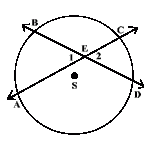Ok, now work with me here. I am only in the 10th grade. I am in Geometry class and we are working on circles. We come across theorem 10.13 about X=1/2 (a+b) you know the deal... but i had the bright idea to ask my teacher if you can solve those other two arcs with the info given. What i have gotten so far is just a little bit but maybe someone else can help...
I thought that if you draw a line in that would be the diameter you would get an inscribed angle. That inscribed angle would tell us that the arc that it creates is going to be 2X. So now you know that arc... You take that arc + the arc you already solved for and you get a number, X. take 180-X and you will get your unknown arc... add all those together and you get 180. Then on the other semicircle you repeat the same process... sorry if i confused anyone but i am completely lost on this one.
I have added a simple diagram that i found on the internet that sums up the base problem... any help would be great

I thought that if you draw a line in that would be the diameter you would get an inscribed angle. That inscribed angle would tell us that the arc that it creates is going to be 2X. So now you know that arc... You take that arc + the arc you already solved for and you get a number, X. take 180-X and you will get your unknown arc... add all those together and you get 180. Then on the other semicircle you repeat the same process... sorry if i confused anyone but i am completely lost on this one.
I have added a simple diagram that i found on the internet that sums up the base problem... any help would be great

